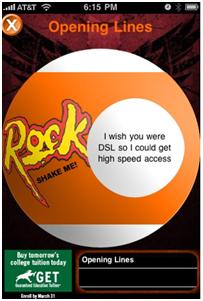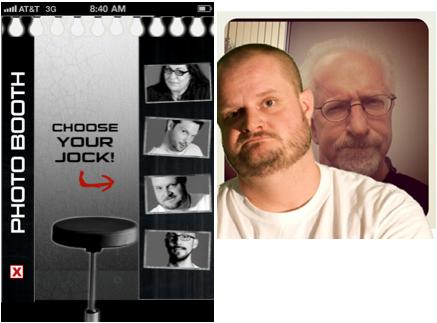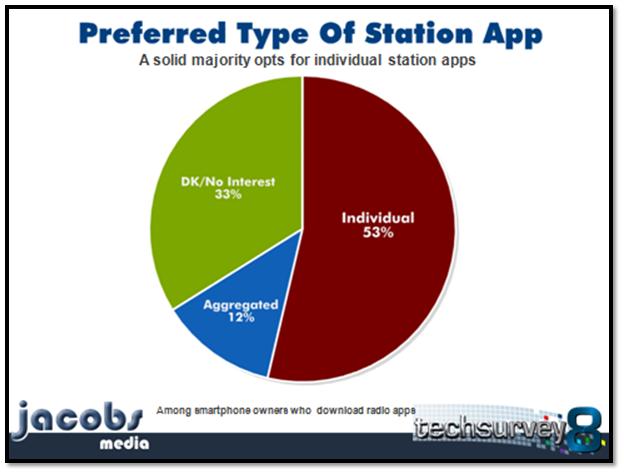In yesterday’s post, we discussed an article from Steve Smith about mobile: “The Age of Branded Action.” Today, let’s take a deeper dive and look at radio brands and how they’re approaching the mobile space.
 In my mind’s eye, I try to picture two guys sitting in a bar. One whips out his smartphone, and says to the other, “Have you seen the app for _________?” And in the process, Guy A shows Guy B something about that app that makes it fun, buzzworthy, and cool.
In my mind’s eye, I try to picture two guys sitting in a bar. One whips out his smartphone, and says to the other, “Have you seen the app for _________?” And in the process, Guy A shows Guy B something about that app that makes it fun, buzzworthy, and cool.
Not all of our apps accomplish that goal, but we try to imbue that philosophy in our design and execution. The successful creation of apps is not analogous to running a factory, where all products end up essentially the same. Nor is the business necessarily scalable in the sense that a template can be used a multitude of times to create the same experience across multiple brands. An ad network can be scaled – great.
The audience demands more than that. Clear Channel deserves all the credit in the world for iHeartRadio, radio’s “umbrella app,” that will ultimately contain the majority of stations under its well-known logo. The addition of Cox and Emmis this week reinforce this notion. iHeart represents hope for radio as it attempts to maintain and build relevancy for radio in the car and other devices.
But consumers want more than just being able to find their favorite stations in a large directory that contains hundreds, if not thousands, of sets of call letters.
Great brands deserve their own apps – that’s what Smith is telling us. And it is a belief held by the vast majority of radio listeners, as we saw vividly in Techsurvey8. The growing numbers of consumers who participate in the apps experience resoundingly tell us that an individually branded app is the way:
As I advise many broadcasters who take the time to ask about the efficacy of joining up with iHeartRadio, why wouldn’t you want to be everywhere? Make your brand available to consumers in radio’s Wal-Mart of apps, but also lovingly create your own app so that your audience can enjoy the true essence of your brand, your personalities, your assets, your essence, your community, and the work that you have devoted to make it great, in many cases, for decades.
In that regard, Clear Channel may be missing the boat, denying the ability for its great individual brands – from Z100 to WDVE – to have their own apps. Companies that make their stations available on mass outlets like TuneIn and iHeartRadio, and then design their own branded mobile masterpieces have their “app cake” – and they eating it, too.
But it’s not enough, and as Smith lays down the gauntlet for radio brands to do more than merely exist on the mobile desktop, it is reminder to all of us in both broadcasting and mobile that incredible opportunities await us in this space – if we devote enough time, energy, and resources to make it happen.
 I look back on some of jacAPPS’ work that has truly allowed the audience to express themselves through radio brands and mobile, and it reinforces the notion that it can be done.
I look back on some of jacAPPS’ work that has truly allowed the audience to express themselves through radio brands and mobile, and it reinforces the notion that it can be done.
At the eleventh hour before the release of the KISW app, we made the decision to add a fun, frivolous, crazy feature – “The 9 Ball” – to the app. Just like those 8-balls that predicted the future when we were kids, shaking your phone with KISW’s app reveals snarky, clever, and funny responses to weekly questions or lists that can be changed whenever the programming and marketing wizards in Seattle get the hankering to.
But that’s the fun, frivolous stuff. Apps have the ability to connect listeners to their communities. WWL’s app shows New Orleans residents nine different radar weather views – for obvious reasons.
Then there are the apps that engage the user with pictures, allowing for personalization, sharing, and creating an affinity for a station’s personalities.
 With the help of the Entercom team, we designed a “Photo Booth” feature for The Buzz in Kansas City, an Alternative station with distinct personalities throughout the day. It was a fun way to capture that essence, involve fans, and take advantage of sharing features with photos.
With the help of the Entercom team, we designed a “Photo Booth” feature for The Buzz in Kansas City, an Alternative station with distinct personalities throughout the day. It was a fun way to capture that essence, involve fans, and take advantage of sharing features with photos.
The potential to engage listeners via mobile is infinite and only limited by the creativity of the station’s team and its developer. Public radio stations, in particular, have the ability to fundraise and connect listeners to their communities, leveraging the passion their listeners have for their programming and their shared values.
These are attributes that are missing in pure plays, providing the ability for radio to do what it does best – serve its three constituencies: audience, advertisers, and communities – in ways that Spotify, Songza, AOL Radio, and Pandora can’t touch.
To just provide a stream on mobile devices and little else is to ignore the incredible power of social sharing – the ability to bring consumers together for common causes from fundraising to sharing playlists. It also minimizes radio’s great brands by reducing them to just their utilitarian functions.
 A lot has been written about SoLoMo – the convergence of social, local, and mobile. In these times, only certain brands can pull this off. It requires a strategy, vision, resources, and the will to get it done. Many local radio stations have these attributes, or at least some of the parts. Budget slashing may have diminished some formerly great radio stations, but many still have the ability to reinvent, rethink, and restrategize how to take advantage of what is already the biggest communication revolution of our lifetimes.
A lot has been written about SoLoMo – the convergence of social, local, and mobile. In these times, only certain brands can pull this off. It requires a strategy, vision, resources, and the will to get it done. Many local radio stations have these attributes, or at least some of the parts. Budget slashing may have diminished some formerly great radio stations, but many still have the ability to reinvent, rethink, and restrategize how to take advantage of what is already the biggest communication revolution of our lifetimes.
So if you decide to still build a Walkman based on the assumption that your brand is so strong that all consumers really want is the ability to listen to you on their phones, think again. And if that’s essentially what your app is all about, don’t be surprised when you see downloads and usage diminish. There is more to your station than just a stream, and in order to be viable in mobile, branded action and engagement via mobile represent the next great challenge – and opportunity.
We are at yet another crossroad with mobile, and for great brands, it is one of the most exciting times imaginable.
Radio truly has the ability to go mobile.
- What To Do If Your Radio Station Goes Through A Midlife Crisis - April 25, 2025
- A 2020 Lesson?It Could All Be Gone In A Flash - April 24, 2025
- How AI Can Give Radio Personalities More…PERSONALITY - April 23, 2025





Leave a Reply